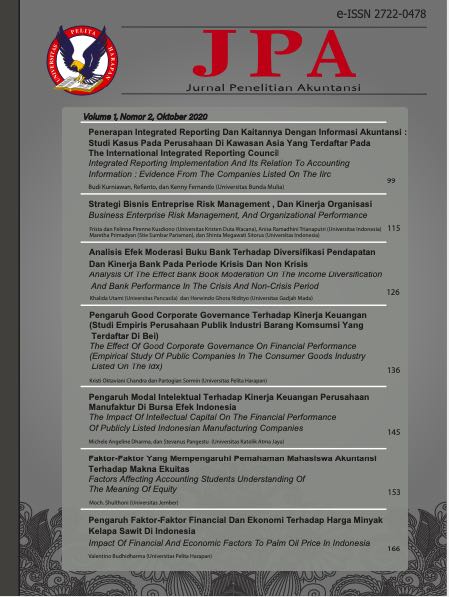STRATEGI BISNIS ENTREPRISE RISK MANAGEMENT , DAN KINERJA ORGANISASI [BUSINESS ENTERPRISE RISK MANAGEMENT, AND ORGANIZATIONAL PERFORMANCE]
Abstract
Abstrak
Penelitian ini bertujuan untuk menguji pengaruh pilihan strategi bisnis perusahaan terhadap kinerja organisasi serta menginvestigasi peran enterprise risk management (ERM) dalam memoderasi pengaruh strategi bisnis terhadap kinerja keuangan dan kinerja operasional perusahaan. Terdapat 558 observasi dalam penelitian ini, yang berasal dari 144 perusahaan sektor manufaktur yang terdaftar di Bursa Efek Indonesia selama periode 2013-2016. Hasil penelitian menunjukkan bahwa terdapat pengaruh positif dari strategi bisnis prospector terhadap kinerja keuangan perusahaan. Namun, tidak terdapat pengaruh yang cukup signifikan dari strategi bisnis prospector maupun defender terhadap kinerja operasional perusahaan. Adapun terkait dengan peran moderasi dari ERM, tidak ditemukan pengaruh moderasi dari ERM terhadap kinerja organisasi, baik pada strategi bisnis prospector dan defender. Namun, terdapat pengaruh langsung yang positif dari ERM terhadap kinerja organisasi. Hasil penelitian ini berimplikasi bahwa ERM, sebagai pendekatan manajemen risiko yang integral dan komprehensif, dapat memainkan peranan penting untuk membantu manajemen dalam menciptakan nilai dan mencapai kinerja organisasi yang optimal.
Kata kunci: strategi bisnis, manajemen risiko perusahaan, kinerja organisasi
Abstract
This study aims to examine the effect of corporate business strategy choices on organizational performance and investigate the role of ERM in moderating the effect of business strategy on financial performance and operational performance of the company. There are 558 observations in this study, derived from 144 manufacturing sector companies listed on the Indonesia Stock Exchange during the period 2013-2016. The results showed that there is a positive effect of business prospector strategy on the company's financial performance. However, there is no significant effect from the business strategy of the prospector or defender on the operational performance of the company. As for the moderating role of ERM, there is no significant effect of ERM on the organization's performance, both on the business prospector and defender strategy. However, there is a positive direct effect of ERM on organizational performance. The results of this study imply that ERM, as a comprehensive risk management approach, can play an important role to assist management in creating value and achieving optimal organizational performance.
Keywords: business strategy, enterprise risk management, organizational performanceReferences
Barton, T.L., Shenkir, W.G. and Walker, P.L. (2002),“Making Enterprise Risk Management Pay Off, Financial Times”, Prentice Hall, Upper Saddle River, NJ.
Beasley, M., Pagach, D., & Warr, R. (2008). Information conveyed in hiring announcements of senior executives overseeing enterprise-wide risk management processes. Los Angeles, CA: SAGE Publications. doi:10.1177/0148558X0802300303
Bettis, R. A. (1983). Modern financial theory, corporate strategy, and public policy: Three conundrums. The Academy of Management Review, 8(3), 406-415. doi:10.5465/AMR.1983.4284379
Bromiley, P., McShane, M., Nair, A., & Rustambekov, E. (2015). Enterprise risk management: Review, critique, and research directions. Long Range Planning, 48(4), 265-276. doi:10.1016/j.lrp.2014.07.005
Conant, J. S., Mokwa, M. P., & Varadarajan, P. R. (1990). Strategic types, distinctive marketing competencies and organizational performance: A multiple measures-based study. Strategic Management Journal, 11(5), 365-383. doi:10.1002/smj.4250110504
Croteau, A., & Bergeron, F. (2001). An information technology trilogy: Business strategy, technological deployment and organizational performance. The Journal of Strategic Information Systems, 10(2), 77-99. doi:10.1016/s0963-8687(01)00044-0
Franco, C., Costantini, A., & Rossi, G. (2013). The Influence Of Business Strategy And Ownership On Management Accounting Innovations And Risk Management Techniques: An Empirical Analysis In Large Manufacturing Companies In Italy.
Gordon, L. A., Loeb, M. P., & Tseng, C. (2009). Enterprise risk management and firm performance: A contingency perspective. Journal of Accounting and Public Policy, 28(4), 301-327. doi:10.1016/j.jaccpubpol.2009.06.006
Hoyt, R. E., & Liebenberg, A. P. (2011). The value of enterprise risk management. The Journal of Risk and Insurance, 78(4), 795-822. doi:10.1111/j.1539- 6975.2011.01413.x
Lam, J. (2014). Enterprise risk management: From incentives to controls (2nd;Second; ed.).
Somerset: Wiley.
Langfield-Smith, K. (1997). Management control systems and strategy: A critical review. Accounting, Organizations and Society, 22(2), 207-232. doi:10.1016/s0361- 3682(95)00040-2
Miles, R. E., Snow, C. C., Meyer, A. D., & Coleman, H. J. (1978). Organizational strategy, structure, and process. The Academy of Management Review, 3(3), 546-562. doi:10.5465/amr.1978.4305755
Nocco, B. W., & Stulz, R. M. (2006). Enterprise risk management: Theory and practice. Journal of Applied Corporate Finance, 18(4), 8-20. doi:10.1111/j.1745- 6622.2006.00106.x
Pagach, D., & Warr, R. (2011). The characteristics of firms that hire chief risk officers. The Journal of Risk and Insurance, 78(1), 185-211. doi:10.1111/j.1539- 6975.2010.01378.x
Parnell, J. A. (1996). Beyond the strategy-performance linkage: The impact of the strategy- organization-environment fit on business performance. American business review, 14(2), .
Salter, Malcolm S., and Wolf A. Weinhold. (1979). Diversification through Acquisition: Strategies for Creating Economic Value . Free Press.
Shirokova, G., & Shatalov, A. (2010). Factors of new venture performance in russia.Management Research Review, 33(5), 484-498. doi:10.1108/01409171011041910
Snow, C. C., & Hrebiniak, L. G. (1980). Strategy, distinctive competence, and
organizational performance. Administrative Science Quarterly, 25(2), 317-336. doi:10.2307/2392457
Stulz, R.M. (1996), Rethinking Risk Management. Journal of Applied Corporate Finance, 9: 8-25. doi:10.1111/j.1745-6622.1996.tb00295.x
Downloads
Published
Issue
Section
License
Authors who publish with this journal agree to the following terms:
1) Authors retain copyright and grant the journal right of first publication with the work simultaneously licensed under a Creative Commons Attribution License (CC-BY-SA 4.0) that allows others to share the work with an acknowledgement of the work's authorship and initial publication in this journal.
2) Authors are able to enter into separate, additional contractual arrangements for the non-exclusive distribution of the journal's published version of the work (e.g., post it to an institutional repository or publish it in a book), with an acknowledgement of its initial publication in this journal.
3) Authors are permitted and encouraged to post their work online (e.g., in institutional repositories or on their website). The final published PDF should be used and bibliographic details that credit the publication in this journal should be included.


